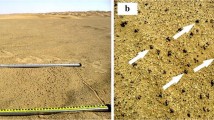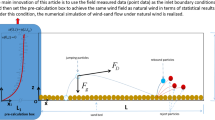Abstract
Studied the moving of airflow around spherical sand particles of diameter 200 μm in solving the problem of the wind removal of soil particles. Used their a regular arrangement on a plane at distances close to or smaller than their diameter with gaps of 50–250, 300, and 700 μm at velocities of 2‒3.1 m/s. The problem is solved using the OpenFOAM open software package. A multilevel mesh adapted to the shape of microrelief elements and smoothing the area of the contact of spherical particles with the lower plane by cylindrical shapes of small radius is applied. The k-type of irregularities with large distances (above 300 µm) is used in calculations of the wind removal of particles. The proximity of the surface resistance values for 50- and 300–700-μm gaps between particles indicates the importance of taking into account the air motion in medium pores (inside a densely packed undersurface layer). The average distances between particles are estimated by analyzing the sand porosity data. It is shown that they correspond to the case of d-type surface irregularities, when the processes in the layer between particles are significant. At distances of 100–250 μm, the region between particles is characterized by the presence of recirculation zones, which determines an order of magnitude greater surface resistance. The dynamic friction velocity is maximum for 200 μm and minimum for 100 μm. The velocity becomes close to the critical value with changes the distance between particles, at which, according to experimental data, a particle of this size can escape from the surface. Values of the viscous surface layer height, which is related to the roughness parameter, agree well with the empirical data for different distances between particles. The buoyancy force acting on the surface particles and calculated proceeding from estimates for the difference of the pressure on the opposite sides of the particles is maximum for the distances of 200 μm between the particle surfaces, minimum for 50 and 100 μm, and gives an inverse pressure against the surface for 150 and 250 μm.










Similar content being viewed by others
REFERENCES
Chou, Y.J. and Fringer, O.B., A model for the simulation of coupled flow bed form evolution in turbulent flows, J. Geophys. Res., 2010, vol. 115, p. C10041. https://doi.org/10.1029/2010JC006103
Greeley, R. and Iversen, D.J., Wind as Geological Process of Earth, Mars, Venus and Titan, New York: Cambridge Univ. Press, 1985.
Gendugov, V.M. and Glazunov, G.P., Vetrovaya eroziya pochvy i zapylenie vozduha (Wind Erosion of the Soil and Dusting of the Air), Moscow: Fizmatlit, 2007.
Baas, J.H., Best, J.L., and Peakall, J., Depositional processes, bedform development and hybrid bed formation in rapidly decelerated cohesive (mud–sand) sediment flows, Sedimentology, 2011, vol. 58, pp. 1953–1987. https://doi.org/10.1111/j.1365-3091.2011.01247.x
Shao, Y., Physics and Modeling of Wind Erosion, New York: Springer, 2008.
Lu, H., An integrated wind erosion modeling system with emphasis on dust emission and transport, Doctoral (Math. Sci.) Dissertarion, Sydney: School Math. Univ. New South Wales, 1999.
Pye, K. and Tsoar, H., Aeolian Sand and Sand Dunes, Netherlands: Springer, 2009. https://doi.org/10.1007/978-3-540-85910-9
Nikuradse, J., Laws of Flow in Rough Pipes, Washington: NACA, 1950.
Gorchakov, G.I., Karpov, A.V., Kopeikin, V.M., Zlobin, I.A., Buntov, D.V., and Sokolov, A.V., Study of the dynamics of saltating sand grains over desertified territories, Dokl. Earth Sci., 2013, vol. 452, pp. 1067–1073. https://doi.org/10.1134/S1028334X1309002X
Bagnold, R.A., The Physics of Blown Sand and Desert Dunes, Netherlands: Springer, 1973. https://doi.org/10.1007/978-94-009-5682-7
Byutner, E.K., Dinamika pripoverkhnostnogo sloya vozdukha (The Dynamics of the Surface Air Layer), Leningrad: Gidrometizdat, 1978.
Semenov, O.E., Vvedenie v eksperimental’nuyu meteorologiyu i klimatologiyu peschanykh bur' (Introduction to Experimental Meteorology and Climatology of Sandstorms), Almaty: 2011.
Anderson, R.S. and Hallet, B., Sediment transport by wind: Toward a general model, GSA Bull., 1986, vol. 97, no. 5, pp. 523–535. https://doi.org/10.1130/0016-7606(1986)97%3C523:STBWTA%3E2.0.CO;2
Dey, S. and Ali, S.Z., Advances in modeling of bed particle entrainment sheared by turbulent flow, Phys. Fluid., 2018, vol. 30, p. 061301. https://doi.org/10.1063/1.5030458
Huang, G., le Ribault, C., Vinkovic, I., and Simoens, S., Large-eddy simulation of erosion and deposition over multiple two-dimensional gaussian hills in a turbulent boundary layer, Bound.-Layer Meteorol., 2019, vol. 173, pp. 193–222. https://doi.org/10.1007/s10546-019-00463-2
Malinovskaya, E.A., Model of sand-particle separation by wind, Izv. Atmos. Ocean. Phys., 2017, vol. 53, pp. 516–523. https://doi.org/10.1134/S0001433817050085
Chkhetiani, O.G., Kalashnik, M.V., and Ingel’, L.K., Generation of thermal wind over a nonuniformly heated wavy surface, Izv. Atmos. Ocean. Phys., 2013, vol. 49, pp. 121–127. https://doi.org/10.1134/S0001433813020059
Ilyin, A.N., Vasiliev, O.A., Ilyina, T.A., and Nikitin, K.P., Influence of resource-saving technology on fertility of grey forest soil, Agrar. Nauch. Zh., 2015, no. 7, pp. 18–22.
Xie, L., Ling, Y., and Zheng, X., Laboratory measurement of saltating sand particles angular velocities and simulation of its effect on saltation trajectory, J. Geophys. Res. Atmos., 2007, vol. 112, p. D12116. https://doi.org/10.1029/2006JD008254
Zheng, X., Mechanics of Wind-Blown Sand Movements, Berlin: Springer, 2009. https://doi.org/10.1007/978-3-540-88254-1
Lorenz, R.D. and Zimbelman, J.R., Dune Worlds: How Windblown Sand Shapes Planetary Landscapes, Berlin: Springer, 2014. https://doi.org/10.1007/978-3-540-89725-5
Williams, J.J., Butterfield, G.R., and Clark, D.G., Aerodynamic entrainment threshold: Effects of boundary layer flow conditions, Sedimentology, 1994, vol. 41, pp. 309–328. https://doi.org/10.1111/j.1365-3091.1994.tb01408.x
Pähtz, T., Valyrakis, M., Zhao, X.-H., and Li, Z.-S., The critical role of the boundary layer thickness for the initiation of aeolian sediment transport, Geosciences, 2018, vol. 8, p. 314. https://doi.org/10.3390/geosciences8090314
Lämmel, M., Rings, D., and Kroy, K., A two-species continuum model for aeolian sand transport, New J. Phys., 2012, vol. 14, p. 093037. https://doi.org/10.1088/1367-2630/14/9/093037
Emmerling, R., The instantaneous structure of the wall pressure under a turbulent boundary layer flow, Mitteil. Max-Planck Inst. Strömungsf., 1973, vol. 9, pp. 1–25.
Gorchakov, G.I., Karpov, A.V., Kuznetsov, G.A., and Buntov, D.V., Quasiperiodic saltation in the windsand flux over desertified areas, Atmos. Ocean. Opt., 2016, vol. 29, pp. 501–506. https://doi.org/10.1134/S102485601606004X
Martin, R.L. and Kok, J.F., Distinct thresholds for the initiation and cessation of aeolian saltation from field measurements, J. Geophys. Res. Earth Surf., 2018, vol. 123, pp. 1546–1565. https://doi.org/10.1029/2017JF004416
Kulikov, A.I., Tsydypov, B.Z., Khamnaeva, G.G., and Sodnomov, B.V., On quantitative parameters of urbanized territory pollution in the context of desertification processes (case study of the town of Zakamensk, Buryatia), Vestn. IrGTU, 2014, no. 12 (95), pp. 75–82.
Dupont, S., Bergametti, G., and Simoens, S., Modeling aeolian erosion in presence of vegetation, J. Geophys. Res. Earth Surf., 2014, vol. 119, pp. 168–187. https://doi.org/10.1002/2013JF002875
Biegert, E., Vowinckel, B., and Meiburg, E., A collision model for grain-resolving simulations of flows over dense, mobile, polydisperse granular sediment beds, J. Comput. Phys., 2017, vol. 340, pp. 105–127. https://doi.org/10.1016/j.jcp.2017.03.035
Liu, Y., Fang, H., Huang, L., and He, G., Numerical simulation of the production of three-dimensional sediment dunes, Phys. Fluid, 2019, vol. 31, p. 096603. https://doi.org/10.1063/1.5108741
Wang, P., Feng, S., Zheng, X., and Sung, H.J., The scale characteristics and formation mechanism of aeolian sand streamers based on large eddy simulation, J. Geophys. Res. Atmos., 2019, vol. 124, pp. 11372–11388. https://doi.org/10.1029/2019jd031081
Wang, C. and Anderson, W., Turbulence coherence within canonical and realistic aeolian dune-field roughness sublayers, Bound.-Layer Meteorol., 2019, vol. 173, pp. 409–434. https://doi.org/10.1007/s10546-019-00477-w
Siminovich, A., Elperin, T., Katra, I., Kok, J.F., Sullivan, R., Silvestro, S., and Yizhaq, H., Numerical study of shear stress distribution over sand ripples under terrestrial and Martian conditions, J. Geophys. Res. Planets, 2019, vol. 124, pp. 175–185. https://doi.org/10.1029/2018JE005701
Yang, X.I.A., Xu, H.H.A., Huang, X.L.D., and Ge, M.-W., Drag forces on sparsely packed cube arrays, J. Fluid Mech., 2019, vol. 880, pp. 992–1019. https://doi.org/10.1017/jfm.2019.726
Michelsen, B., Strobl, S., Parteli, E.J.R., and Pöschel, T., Two-dimensional airflow modeling underpredicts the wind velocity over dunes, Sci. Rep., 2015, vol. 5, p. 16572. https://doi.org/10.1038/srep16572
Lignarolo, L., Gorlé, C., Parente, A., and Benocci, C., in Proceedings of the 13th International Conference on Wind Engineering ICWE13, Amsterdam, Netherlands, July 10–15, 2011. https://www.researchgate.net/publication/247778744_Large_eddy_simulation_of_the_atmosp heric_boundary_layer_using_OpenFOAM.
Ali, M.S.M., Salim, S.A.Z.S., Ismail, M.H., Muhamad, S., and Mahzan, M.I., Aeolian tones radiated from flow over bluff bodies, Open Mech. Eng. J., 2013, vol. 7, pp. 48–57. https://doi.org/10.2174/1874155X01307010048
Araújo, A.D., Parteli, E.J.R., Pöschel, T., Andrade, J.S., and Herrmann, H.J., Numerical modeling of the wind flow over a transverse dune, Sci. Rep., 2013, vol. 3, p. 2858. https://doi.org/10.1038/srep02858
Faria, R., Ferreira, A.D., Sismeiro, J.L., Mendes, J.C.F., and Sousa, A.C.M., Wind tunnel and computational study of the stoss slope effect on the aeolian erosion of transverse sand dunes, Aeolian Res., 2011, vol. 3, pp. 303–314. https://doi.org/10.1016/j.aeolia.2011.07.004
Kang, L. and Guo, L., Eulerian–Lagrangian simulation of aeolian sand transport, Powder Tech., 2006, vol. 162, pp. 111–120. https://doi.org/10.1016/j.powtec.2005.12.002
Parsons, D.R., Wiggs, G.F.S., Walker, I.J., Ferguson, R.I., and Garvey, B.G., Numerical modelling of airflow over an idealised transverse dune, Environ. Model. Software, 2004, vol. 19, pp. 153–162. https://doi.org/10.1016/S1364-8152%2803%2900117-8
Schatz, V. and Herrmann, H.J., Flow separation in the lee side of transverse dunes: A numerical investigation, Geomorphology, 2006, vol. 81, pp. 207–216. https://doi.org/10.1016/j.geomorph.2006.04.009
Tong, D. and Huang, N., Numerical simulation of saltating particles in atmospheric boundary layer over flat bed and sand ripples, J. Geophys. Res. Atmos., 2012, vol. 117, p. D16205. https://doi.org/10.1029/2011JD017424
Turpin, C., Badr, T., and Harion, J.-L., Numerical modelling of aeolian erosion over rough surfaces, Earth Surf. Process. Landforms, 2010, vol. 35, pp. 1418–1429. https://doi.org/10.1002/esp.1980
Zheng, X.J., Bo, T.L., and Xie, L., DPTM simulation of aeolian sand ripple, Sci. China, Ser. G: Phys. Mech. Astron., 2008, vol. 51, pp. 328–336. https://doi.org/10.1007/s11433-008-0020-y
Li, Y. and Guo, Y., Numerical simulation of aeolian dusty sand transport in a marginal desert region at the early entrainment stage, Geomorphology, 2008, vol. 100, pp. 335–344. https://doi.org/10.1016/j.geomorph.2008.01.006
Ji, S.B., Gerber, A.G., and Sousa, A.C.M., A convection–diffusion CFD model for aeolian particle transport, Int. J. Numer. Meth. Fluid., 2004, vol. 45, pp. 797–817. https://doi.org/10.1002/fld.724
Deryabina, M.S. and Martynov, S.I., Simulation of the flow of a viscous fluid with particles through porous medium cells, Vychisl. Mekh. Splosh. Sred, 2016, vol. 9, no. 4, pp. 420–429. https://doi.org/10.7242/1999-6691/2016.9.4.35
Martynov, S.I. and Tkach, L.Yu., Dynamics of chain particle aggregates in viscous flow, Comput. Math. Math. Phys., 2016, vol. 56, pp. 826–840. https://doi.org/10.1134/S0965542516050158
Garbaruk, A.V., Strelets, M.H., and Shur, M.L., Modelirovanie turbulentnosti v raschetakh slozhnykh techenii (Turbulence Modeling in Complex Flow Calculations), St. Petersburg: Politekh. Univ., 2012.
Perry, A.E., Schofield, W.H., and Joubert, P.N., Rough wall turbulent boundary layers, J. Fluid Mech., 1969, vol. 37, pp. 383–413. https://doi.org/10.1017/S0022112069000619
The OpenFOAM® Foundation. http://www.openfoam.org/index.php.
Krumbein, W.C., Size frequency distributions of sediments and the normal phi curve, J. Sediment. Res., 1938, vol. 8, no. 3, pp. 84–90. https://doi.org/10.1306/D4269008-2B26-11D7-8648000102C1865D
Bauer, B.O., Houser, C.A., and Nickling, W.G., Analysis of velocity profile measurements from wind-tunnel experiments with saltation, Geomorphology, 2004, vol. 59, pp. 81–98. https://doi.org/10.1016/j.geomorph.2003.09.008
Gu, Z., Zhao, Y., Li, Y., Yu, Y., and Feng, X., Numerical simulation of dust lifting within dust devils-simulation of an intense vortex, J. Atmos. Sci., 2006, vol. 63, no. 10, pp. 2630–2641. https://doi.org/10.1175/JAS3748.1
Roney, J.A. and White, B.R., Definition and measurement of dust aeolian thresholds, J. Geophys. Res. Earth Surf., 2004, vol. 109, p. F01013. https://doi.org/10.1029/2003JF000061
Minvielle, F., Marticorena, B., Gillette, D.A., Lawson, R.E., Thompson, R., and Bergametti, G., Relationship between the aerodynamic roughness length and the roughness density in cases of low roughness density, Environ. Fluid Mech., 2003, vol. 3, pp. 249–267. https://doi.org/10.1023/A:1022830119554
Durst, F., Miloievic, D., and Schönung, B., Eulerian and Lagrangian predictions of particulate two-phase flows: A numerical study, Appl. Math. Model., 1984, vol. 8, pp. 101–115. https://doi.org/10.1016/0307-904X(84)90062-3
Krupp, H., Particle adhesion: Theory and experiment, Adv. Colloid Interface Sci., 1967, vol. 1, pp. 111–239. https://doi.org/10.1016/0001-8686(67)80004-6
ACKNOWLEDGMENTS
We are grateful to L.O. Maksimenkov for permanent support and help in the work on the computational cluster of the Obukhov Institute of Atmospheric Physics, Russian Academy of Sciences, as well as to M.V. Kraposhin and S.V. Strizhak for the support in learning the operational principles of OpenFOAM, and the Ivannikov Institute for System Programming, Russian Academy of Sciences, for kindly provided resources.
Funding
The study was supported by the Russian Science Foundation, project no. 20-17-00214.
Author information
Authors and Affiliations
Corresponding author
Additional information
Translated by A. Nikol’skii
Rights and permissions
About this article
Cite this article
Malinovskaya, E., Chkhetiani, O. On Conditions for the Wind Removal of Soil Particles. J Appl Mech Tech Phy 62, 1117–1131 (2021). https://doi.org/10.1134/S0021894421070154
Received:
Revised:
Accepted:
Published:
Issue Date:
DOI: https://doi.org/10.1134/S0021894421070154




